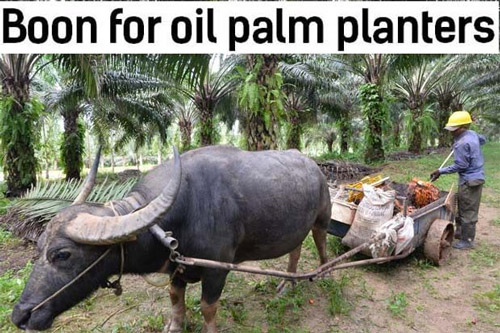
Weak Ringgit Translates to Higher Revenue for Oil Palm Planters
PETALING JAYA: The weaker ringgit is a boon for oil palm planters.
At RM2,284 a tonne yesterday, crude palm oil (CPO) futures contract on Bursa Derivatives, which is quoted in ringgit, has risen 18.4% from the recent low in August.
Over the same period, rival soybean oil gained 1.7%. Palm oil and soybean oil are substitutes and their price movements usually track each other.
But as the ringgit depreciates and the US dollar appreciates, palm oil’s appeal to cost-conscious consumers increases.
Malaysia ranks second after Indonesia as the world’s top palm oil exporter.
The ringgit slumped 0.65% yesterday to 3.5567 against the US dollar, it weakest level in more than five years. The local currency has fallen 12.7% against the greenback since the beginning of September.
“A weaker ringgit or rupiah results in higher translated local revenue and profits for the Malaysian and Indonesian planters, who report earnings in ringgit or rupiah as CPO exports are traded in US dollars globally,’’ Maybank Research said in a report yesterday.
The price of palm oil is also being supported by supply fears.
Analysts expect palm oil production in the flood-affected states to be reduced in the coming months.
CIMB Research said in a recent report that the four worst-hit states of Terengganu, Pahang, Kelantan and Perak accounted for 30% of Malaysia’s palm oil supply in 2013.
The firm’s plantation analyst Ivy Ng said the floods would keep CPO prices firm in the near term due to the weaker supply from Malaysia, but were negative for the planters who were affected.
“Planters who are impacted by the floods would likely see weaker earnings in the fourth quarter, as a slight rise in CPO prices would not be sufficient to offset the drop in output,” Ng said.
However, RHB Research’s plantation analyst Alvin Tai said the impact from the potential monsoon surge may bring some upside from present levels, but it was “not going to be much”.
“The impact from the floods is usually quite short term in nature and I am inclined to think that the impact from the floods may not last for long.
“The market also needs to consider the dryness impact that will kick in from the first quarter of 2015, which would result in low production and aggravate the seasonal slowdown,” Tai said.
Source : The Star
]]>
